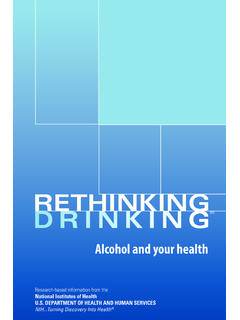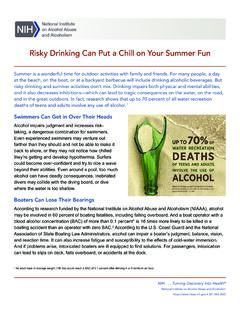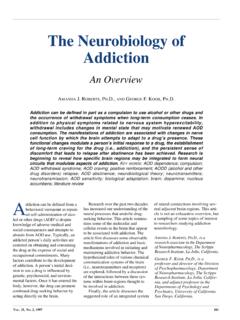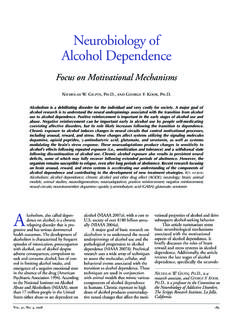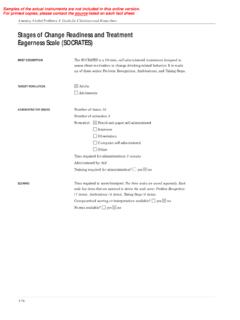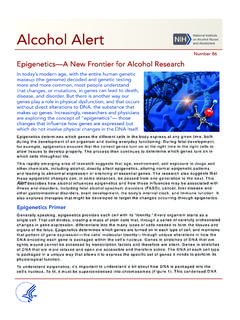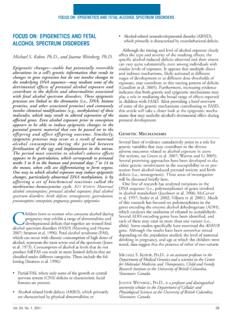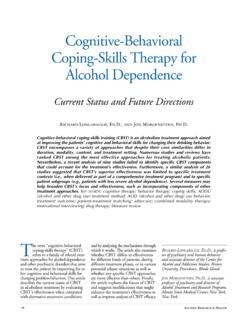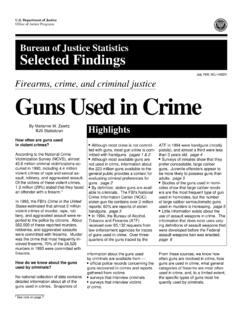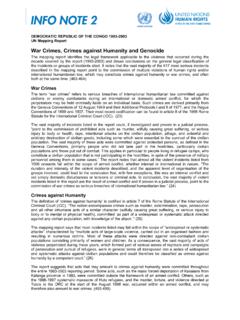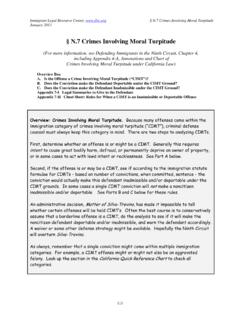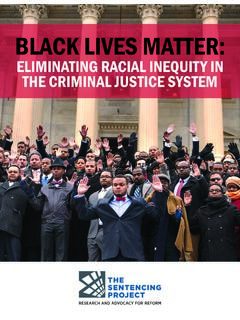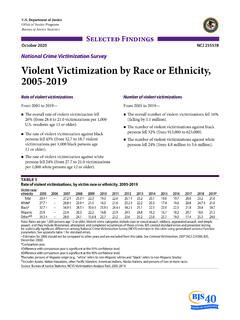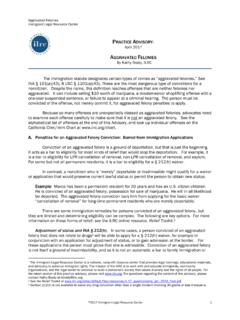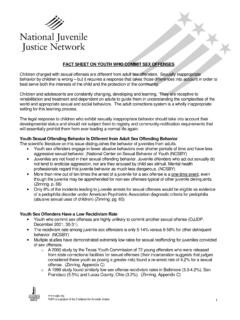Transcription of Alcohol and Violence - National Institutes of Health
1 54 Chapter 1: Drinking Over the Life Span: Issues of Biology,Behavior,and RiskOf the million victims of violent crime eachyear, almost one in four, or million, reportthat the offender had been drinking Alcohol priorto committing the crime (Greenfeld 1998).Among the attacks that were committed bycurrent or former intimate partners of the vic-tims, two out of three of the offenders had beendrinking prior to the attack (Greenfeld 1998).Over the years, consistent findings such as thesehave stimulated research into factors that mightcontribute to Alcohol -related Violence and thequestion of whether Alcohol use is not merelyassociated with, but perhaps a cause of, Violence is the result of complexinteractions between individual and environ-mental factors that either promote or inhibitviolence. Findings from numerous studiesimplicate several variables including personalityfactors, individual expectancies, situationalelements, and sociocultural influences that may interact with Alcohol s pharmacologic is not clear is whether and under whatcircumstances these interactions may combine to lead to violent episodes.
2 It is also not knownwhat interventions might prevent or reduce thelikelihood of Alcohol -related recent years, however, using increasinglysophisticated methodology, researchers have madeadvances in understanding the individual andenvironmental factors related to Alcohol andviolence and in addressing the issue of addition, the field is progressing as a result of new theoretical frameworks that describe the complex interplay between individual andenvironmental influences and incorporate an interactional level that is influenced by section focuses on recent developments inthese at the individual level include investi-gations of Alcohol use by both the offender andthe victim. Regarding the offenders, research haslong indicated that there is an association betweendrinking and the perpetration of violent acts (forreviews see Collins 1981, 1989; Lipsey et ; Pernanen 1976, 1981, 1991; Roizen 1993,1997). More recent research has extended thisfinding by examining related items of interestsuch as variations by the amount of Alcohol used, the severity of the ensuing injuries, and the social relationship between the offender and the the victims of Alcohol -linked Violence ,studies have investigated risk factors for becominga victim and have examined whether Alcohol con-sumption by the victims, as well as the offenders,might influence those risks.
3 Although the studyof Alcohol use by victims is newer and somewhatless developed, it is proceeding along some of thesame avenues as research on offenders, such aslooking at the relationships between offenders and section also reviews studies about environ-mental factors in the relationship between alcoholand Violence . These include studies of individualbars and street locations as well as studies ofcomparative crime rates across cities and key variable in this research is sometimesalcohol availability rather than Alcohol consump-tion. The expectation is that decreased availabil-ity might lead to decreased consumption, whichmight lead in turn to lower rates of is of interest because it is a potential policy lever that could be manipulated if acausal relationship between availability andviolence rates were firmly important goal of this research is to advancebeyond simply finding that Violence rates increasewith increasing Alcohol consumption, to movetoward scientific results that would strengthen our ability to conclude whether this relationshipis causal.
4 Two kinds of environmental or policy-based studies are useful steps in this direction: Alcohol and ViolenceAlcohol and Violence55those that gather data at set intervals over time,and those that gather data both across time and at different pursue across-time studies by collect-ing data in several waves over time (longitudinalsurvey studies) or by analyzing regularly collecteddata series, such as annual homicide rates forcities (time-series studies). These study designshelp to establish the temporal relationshipsbetween variables, an important step towarddemonstrating causality. Even though, forexample, variables A and B might be related in the sense that whenever A happens, B alsohappens, A cannot be said to cause B unless Ahappens before B. Furthermore, when data arecollected regularly over time, studies can revealsuch associations as two variables rising andfalling in synchrony. Demonstration of this kindof relationship would provide more persuasiveevidence of an underlying causality than, forexample, the finding of a one-time connectionamong variables through a cross-sectional either case, however, an apparent relationshipbetween two variables may actually be caused by a third, unknown factor.
5 Thus, studies thatattempt to establish causality must not onlydetermine the timing of events, but also identifyand measure the effects of any intervening factorsthat may have affected the effective than the across-time approachalone is one that also gathers data from severaldifferent locations (across time and across space,or a pooled, cross-sectional, time-series analysis ).These designs give researchers a particularlystrong basis for attributing causality in the find-ings. Recent work on environmental contribu-tions to Violence has pursued both paths in orderto gain deeper insights into the question included in this section is a review of somerecent theoretical developments in the field ofalcohol and Violence . In addition to advancesmade through research, the knowledge base inthis field can increase through the development ofnew conceptualizations to explain facts or emerging, these conceptualizations becomeshared among scientists and eventually are testedin studies.
6 Thus, a look at the developingtheories is a preview of the kinds of empiricalstudies that are likely to be conducted , a few words on the scope of this , it does not address self-inflicted Violence (that is, suicide). Second, it focuses on epidemio-logic or population-based studies and thus omitsample research using laboratory animals (forreviews of this literature see Brain et al. 1993;Higley and Linnoila 1997; Miczek et al. 1997;Yudko et al. 1997) and human laboratory experi-mental studies (for recent meta-analyses of thisliterature see Bushman 1997; Lipsey et al. 1997).These studies suggest that there is no simple orinevitable relationship between Alcohol andaggression. Psychopharmacologic, personality,cognitive, and situational factors all appear to playimportant roles in influencing whether violencewill occur. Nevertheless, experimental findingsdo suggest that, in laboratory settings, alcoholtends to increase aggressive responses in a waythat might be interpreted as relatively strongsupport for a causal effect of Alcohol consumptionon Studies:Drinking by OffendersThe National Crime Victimization Survey(NCVS) has found consistently that Alcohol ismore likely than other drugs to be involved insubstance-related Violence .
7 According to datafrom 1992 through 1995, nearly one-fourth of all victims of violent incidents were reasonablycertain that one or more of the offenders hadbeen drinking Alcohol before committing theoffense (Greenfeld 1998). In 20 percent of allincidents the offender used Alcohol only; in 5 percent the offender used both Alcohol andother drugs; and in 1 percent the offender wasknown to be under the influence but it was notknown whether the offender was using Alcohol or drugs (figure 1). By comparison, in only 5 percent of the incidents was the assailantreported to be under the influence of drugs but not Alcohol . Thus, despite the popularconception that violent crime is strongly linked to drug use by offenders, this study indicates that56 Chapter 1: Drinking Over the Life Span: Issues of Biology,Behavior,and Riskthere is actually a much greater probability thatany given violent incident will be related toalcohol use than to use of other drugs by , the 25-percent estimate of drinkingamong offenders reported by the NCVS is likelyto be an underestimate.
8 This is because homi-cides, which are omitted from the NCVS data,consistently have a higher proportion of alcoholinvolvement than do the less serious forms ofviolence that are included in the NCVS (forreviews see Collins and Messerschmidt 1993;Lipsey et al. 1997; Murdoch et al. 1990; Pern-anen 1991; Roizen 1993). For example, in one recent study where 268 homicide offenderswere interviewed about their crimes, 32 percentreported being intoxicated at the time of theoffense (Spunt et al. 1994, 1995). In a study of 1,768 homicide case records in New York State in 1984 through 1988, more than 47 per-cent of the homicides involved Alcohol use by the offender (Goldstein et al. 1992). In addition,according to the Bureau of Justice Statistics,convicted murderers in State prisons reported that Alcohol was a factor in half the murders theyhad committed, with Alcohol involvement higherin murders of intimates (54 percent) than mur-ders of acquaintances (50 percent) or strangers(47 percent) (Green-feld 1998).
9 Not only is the use of Alcohol prevalent amongoffenders, but the amount of Alcohol consumed at the time of the offense is likely to be quite high(Greenfeld 1998). In one study, the estimatedaverage blood Alcohol concentration (BAC) ofoffenders who had been drinking was in the rangeof double or triple the thresholds of impairmentmost commonly used in State driving whileintoxicated (DWI) laws. The study estimatedaverage BAC s of percent for probationers, percent for local jail inmates, and percent for State prisoners at the time of their offense, while blood Alcohol limits forDWI are usually either or percent(Greenfeld 1998).A broad-based review of the literature onindividual-level studies of offenders drinking and Violence among both adolescents andadults yielded a somewhat similar picture of the relationship between drinking and violentbehavior (Lipsey et al. 1997). This review of 129 studies published between 1950 and 1994found repeated evidence of an overall relationshipbetween greater Alcohol use and criminal anddomestic Violence , with particularly strongevidence in studies of domestic Violence .
10 How-ever, when researchers accounted for a greaternumber of control variables (such as gender,age, social class, criminal status, childhood abuse,and use of other drugs in addition to Alcohol ),they tended to find that these control variablesweakened the strength of the original relationshipbetween Violence and Alcohol consumption, insome cases to the point of no association. Forexample, in 6 of the 14 studies of criminalviolence that had data on control variables, no statistically significant relationship betweenalcohol and Violence remained after the influenceof control variables was removed. In the domesticviolence studies, however, while control variablesreduced the association, 11 of the 13 studiesreported statistically significant levels of associ-ation that remained after the analysis controlledfor other variables. The researchers concludedthat, although research to date shows substantialevidence of an association between Alcohol andviolence that is consistent with a causal relation-ship, it will not be possible to state conclusivelyPercent of victims of violent crimeFigure 1: Among victims of violent crime,percentage who were certain that theoffender had been drinking or using otherdrugs before committing the crime0%10%20%30%40% Alcohol onlyAlcohol and drugsAlcohol or drugsDrugs onlyNo drugs or alcoholDon t knowSource: Greenfeld and Violence57that Alcohol causes Violence until further research using a wider array of control variables is and the Severity of Violence andInjuriesStudies have generally found that the moreserious the crime or injuries, the more likelyalcohol was involved.
